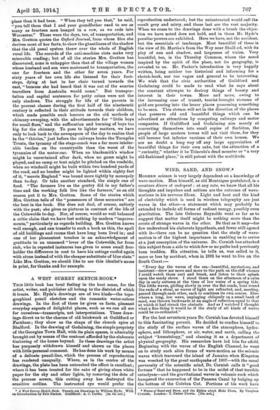WIND, SAND, AND SNOW.*
MODERN science is very largely dependent on a knowledge of wave-motion. Man himself, as old Montaigne postulated, is a creature divers of ondoyant at any rate, we know that all his thoughts and impulses and actions are the outcome of wave- motions in his nervous fibres. Light and heat and the kind of electricity which is used in wireless telegraphy are just waves in the ether—a statement which may probably be extended to include all forms of radiant energy, possibly even gravitation. The late Osborne Reynolds went so far as to suggest that matter itself might be nothing more than the crests of strange waves in the ether. Be that as it may—for few understood his elaborate hypothesis, and fewer still agreed with it—there can be no question that the study of wave- motion is of the highest importance in enabling us to arrive at a just conception of the universe. Dr. Cornish has attacked this subject from a side to which few or no paths bad previously been trodden. His attention, he tells us, was called to it, more or less by accident, when in DM he went to live on the
South Coast
"Every day the waves of the sea—beautiful, mysterious, and insistent—drew me more and more to the path on the cliff whence I could watch them curl and break, and listen to their splash upon the sandy shore. I stood there on the afternoon of a calm day in early autumn at the time of low water of a spring tide. The little waves, gliding slowly in over the flat sands, bent round the ends of a shoal, as waves of light are refracted, and, meeting, passed through each other, each to continue its own course. Else- where a long, low wave, impinging obliquely on a small bank of sand, was thrown backwards at an angle of reflection equal to that at which it had struck the obstacle. And as I watched I thought what a fine thing it would be if the study of all kinds of waves could be co-ordinated."
For the last seventeen years Dr. Cornish has devoted himself to this fascinating pursuit. He decided to confine himself to the study of the surface waves of the atmosphere, hydro- sphere, and lithosphere, or air, water, and earth, calling the subject "kamatology," and classing it as a department of physical geography. His researches have led him far afield. Beginning with the waves of the English Channel, he went on to study such alien forms of wave-motion as the seismic waves which traversed the island of Jamaica when Kingston was wrecked by the great earthquake of 1907—with the usual perversity of the scientific mind, Dr. Cornish calls it "good fortune" that he happened to be in the midst of that terrible cataclysm—and the gravitational waves in volcanic rock which hampered the excavation of the Panama Canal by bulging up the bottom of the Culebra Cat. Portions of his work have • Waves of Sand and Snow, and the Eddies 'Odds Make Them. By Vaughan Cornish. London: T. Fisher Unwin. E100, set.) already been given to the world in a score or so of scientific papers on special points and in a book— Waves of the Sea and other Water Waves—which he published about four years ago. In the present volume he deals with the " progressive transverse inequalities " produced by wind or water in sand and snow. The more familiar action of wind is to obliterate the transverse and create longitudinal inequalities. Yet, under certain con- ditions, the smooth surface of desert sand and prairie snow is ruffled transversely by the wind. "The means by which these waves of sand and snow originate, grow, and more are peculiar and interesting." Dr. Cornish also records incidental investi- gations of mackerel skies (cloud ripples), snow-mushrooms, quicksands, and other allied subjects. The admirable illustra- tions add charm to a most valuable and instructive piece of patient labour.



























































 Previous page
Previous page